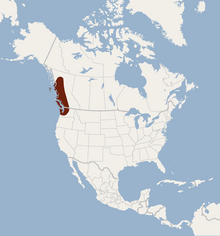Keen mouse-eared
| Keen mouse-eared | ||||||||||||
|---|---|---|---|---|---|---|---|---|---|---|---|---|
| Systematics | ||||||||||||
|
||||||||||||
| Scientific name | ||||||||||||
| Myotis keenii | ||||||||||||
| ( Merriam , 1895) |
The Keen mouse- eared bat ( Myotis keenii ) is a species of bat from the smooth-nosed family (Vespertilionidae), which is native to North America. The species is named after John Henry Keen , who collected the holotype . In some publications, the species is viewed as the western population of the North American mouse-eared mouse ( Myotis septentrionalis ); however, new molecular studies show that the species is more closely related to the northern long-eared mouse-eared mouse ( Myotis evotis ).
description
The Keen mouse- eared bat is a small bat with a head-to-trunk length of less than 50 mm and an average forearm length of 36.4 mm. The ears protrude beyond the muzzle when put forward, the tail membrane is slightly hairy on the edge. The coat color is brown with a lighter belly side.
Way of life
The Keen mouse-eared mouse is less common and occurs in smaller groups than other types of mouse-eared mousehouses in North America. Accordingly, relatively little is known about the species. Their range is one of the smallest of all bats in North America. Colonies in hibernation roosts reach a size of up to 350 individuals. The species often shares these roosts with other bat species such as the small and large brown bat ( Myotis lucifugus and Eptesicus fuscus ), the eastern small-footed mouse- eared bat ( Myotis leibii ) and the eastern American pipistrelle ( Perimyotis subflavus ). The Keen mouse-ear prefers cool, damp corners without a draft. In the northern distribution areas, the species goes into hibernation as early as August, which can last up to nine months.
Like most bats, the species is nocturnal and feeds on insects. During the day she sleeps under tree bark or similar structures, such as behind shutters , as well as in crevices in the rock. Mating takes place before hibernation , with the females storing the sperm and the egg not being fertilized until spring. During and after birth, the females gather in groups of up to 40 individuals. The males mostly stay to themselves at this time. It is known from ringing data that the Keen mouse-eared mouse can live to be over 18 years old.
distribution and habitat
The Keen mouse-eared mouse is found in northwest Washington and southwest British Columbia . Thanks to its widespread distribution, the IUCN has classified its population as stable and the species as safe.
literature
- JH Fitch, KA Shump (1979): Myotis keenii . In: Mammalian Species , No. 121, pp. 1-3
swell
- ↑ Myotis keenii in the IUCN Red List of Threatened Species .
